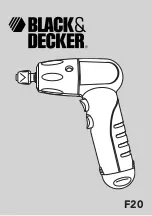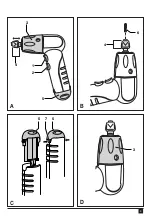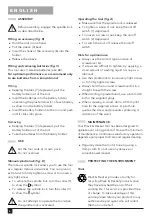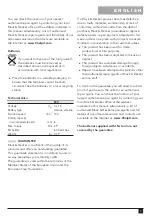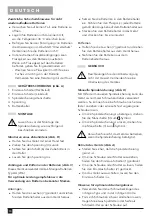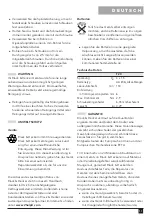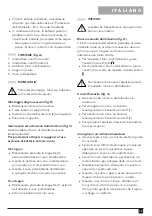
5
E N G L I S H
General
1. Keep work area clean
Cluttered areas and benches can cause accidents.
2. Consider work area environment
Do not expose the tool to rain. Do not use the
tool in damp or wet conditions. Keep the work
area well lit. Do not use the tool where there is
a risk of causing fire or explosion, e.g. in the
presence of flammable liquids and gases.
3. Keep children away
Do not allow children, visitors or animals to
come near the work area or to touch the tool.
4. Dress properly
Do not wear loose clothing or jewellery, as these
can be caught in moving parts. Preferably wear
rubber gloves and non-slip footwear when
working outdoors. Wear protective hair
covering to keep long hair out of the way.
5. Personal protection
Always use safety glasses. Use a face or dust
mask whenever the operations may produce
dust or flying particles. Wear ear protection
whenever the sound level seems uncomfortable.
6. Do not overreach
Keep proper footing and balance at all times.
7. Stay alert
Watch what you are doing. Use common sense.
Do not operate the tool when you are tired.
8. Secure workpiece
Use clamps or a vice to hold the workpiece. It is
safer and it frees both hands to operate the tool.
9. Use appropriate tool
The intended use is described in this instruction
manual. Do not force small tools or attachments
to do the job of a heavy-duty tool. The tool will
do the job better and safer at the rate for
which it was intended. Do not force the tool.
Warning!
The use of any accessory or attachment
or performance of any operation with this tool
other than those recommended in this instruction
manual may present a risk of personal injury.
10. Check for damaged parts
Before use, carefully check the tool for
damage. Check for misalignment and seizure
of moving parts, breakage of parts, damage to
guards and switches and any other conditions
that may affect its operation.
Ensure that the tool will operate properly and
perform its intended function. Do not use the
tool if any part is damaged or defective. Do not
use the tool if the switch does not turn it on
and off. Have any damaged or defective parts
repaired or replaced by an authorised repair
agent. Never attempt any repairs yourself.
11. Avoid unintentional starting
Do not carry the tool with a finger on the
on/off switch.
12. Store idle tools
When not in use, tools and batteries should be
stored in a dry, locked up or high place, out of
reach of children.
13. Maintain tools with care
Keep cutting tools sharp and clean for better
and safer performance. Follow the instructions
for maintenance and changing accessories.
Keep handles and switches dry, clean and free
from oil and grease.
14. Repairs
This tool complies with relevant safety
requirements. Repairs should only be carried
out by qualified persons using original spare
parts; otherwise this may result in considerable
danger to the user.
Additional safety instructions for
non-rechargeable batteries
◆
Never attempt to open for any reason.
◆
Do not store in locations where the temperature
may exceed 40 °C.
◆
When disposing of batteries, follow the
instructions given in the section “Protecting the
environment”. Do not incinerate the batteries.
◆
Under extreme conditions, battery leakage
may occur. When you notice liquid on the
batteries, proceed as follows:
- Carefully wipe the liquid off using a cloth.
Avoid skin contact.
OVERVIEW (fig. A)
1. On/off switch (forward)
2. On/off switch (reverse)
3. Spindle lock collar
4. Bit holder sleeve
5. Battery holder
Содержание F20
Страница 1: ...1 F20 ...
Страница 3: ...3 3 1 2 5 4 4 6 5 7 5 3 B A D C ...
Страница 56: ...56 ...
Страница 57: ...57 ...

